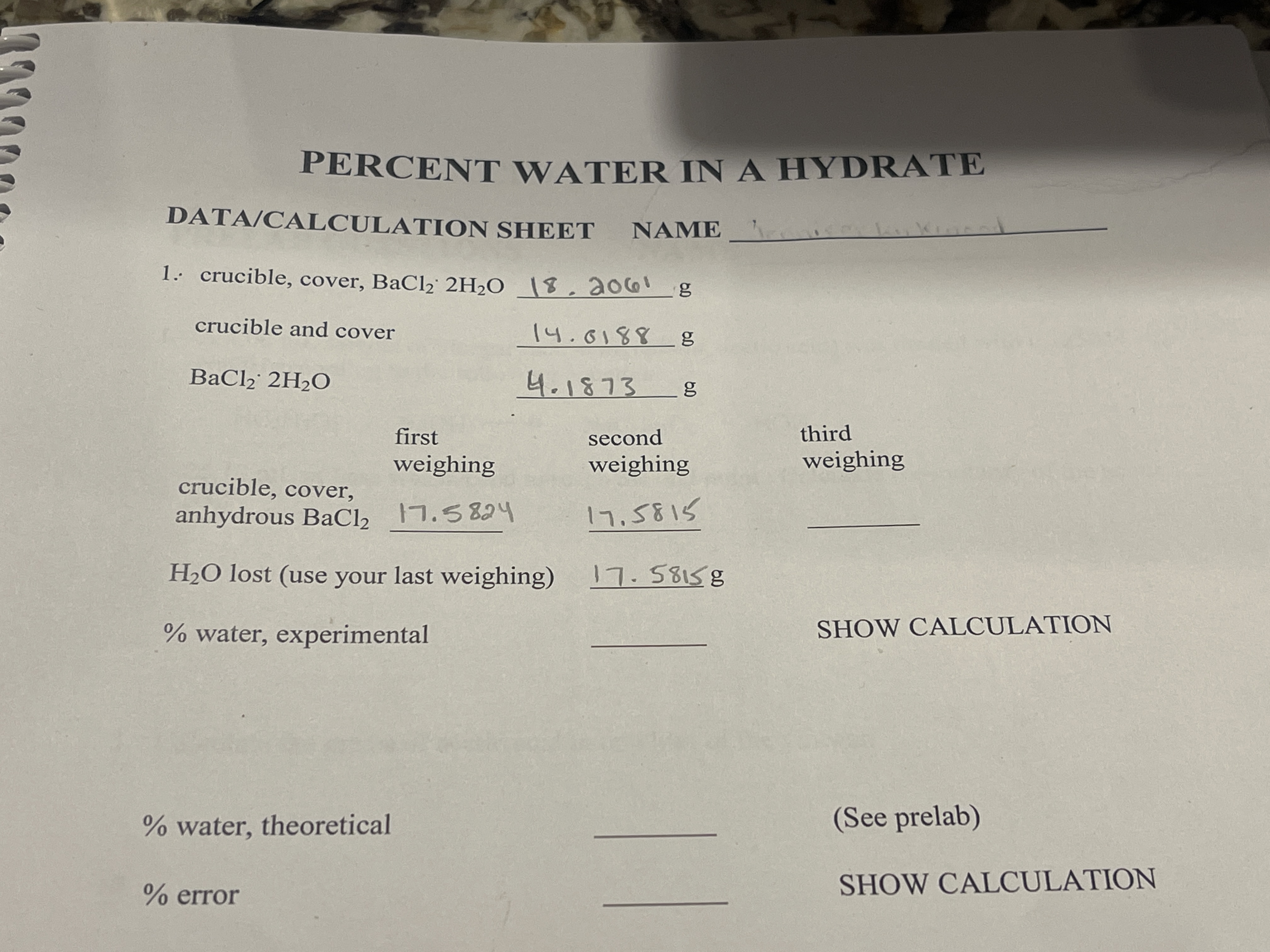
Chemistry
10th Edition
ISBN: 9781305957404
Author: Steven S. Zumdahl, Susan A. Zumdahl, Donald J. DeCoste
Publisher: Cengage Learning
expand_more
expand_more
format_list_bulleted
Concept explainers
Question

Transcribed Image Text:PERCENT WATER IN A HYDRATE
DATA/CALCULATION SHEET
NAME
1.. crucible, cover, BaCl2 2H2O _\8, a0G! g
crucible and cover
14.0188g
BaCl 2H2O
4.1873 g
first
second
third
weighing
weighing
weighing
crucible, cover,
anhydrous BaCl, 7.5824
17.5815
H2O lost (use your last weighing)
17.58158
% water, experimental
SHOW CALCULATION
% water, theoretical
(See prelab)
% error
SHOW CALCULATION
Expert Solution
This question has been solved!
Explore an expertly crafted, step-by-step solution for a thorough understanding of key concepts.
This is a popular solution
Trending nowThis is a popular solution!
Step by stepSolved in 2 steps with 2 images

Knowledge Booster
Learn more about
Need a deep-dive on the concept behind this application? Look no further. Learn more about this topic, chemistry and related others by exploring similar questions and additional content below.Similar questions
- Aqueous hydrochloric acid (HC1) reacts with solid sodium hydroxide (NaOH) to produce aqueous sodium chloride (NaCl) and liquid water (H₂O). If 0.558 g of water is produced from the reaction of 2.6 g of hydrochloric acid and 2.1 g of sodium hydroxide, calculate the percent yield of water. Round your answer to 2 significant figures. Ď% X Śarrow_forward5.71 g of nitrogen reacts with a certain amount of hydrogen according to the following reaction: 3 H2 + N2 → 2 NH3 How many grams of hydrogen would be required to react with 5.71 g of nitrogen ? Select ALL the conversion factors needed for this calculation using dimensional analysis method. 1) 1 mol N2/3mol H2 2) 28.02 g N2/ 1mol N2 3)1 mol H2/2.016 g H2 4)2.016 g H2/1mol H2 5)1 mol N2/28.02 g N2 6) 3 mol H21 mol N2arrow_forwardmistry app.101edu.co YouTube Maps NG AMOUNT * @ 7 2 X W S F2 X Jill # Welcome to MyTCC Welcome to MyTCC 3 F3 E D C 20: $ 4 R F 30 % 35.6 V Aluminium has a density of 2.70 g/cm² How many moles of aluminum are in a 13.2 cm block of the metal substance? 4 ADD FACTOR X x() F5 5 molecules Al T Content G 1.32 F6 A 6 B 2.70 0.489 g Al/mol F7 Y & H Question 1 of 50 0.100 g/cm² W 7 26.98 N ASUS X F8 U J g Al Lo b Home | bartleby ANSWER 8 962 13.2 F9 | M mol Al 1 1 K F10 9 < I RESET 5 6.022 x 10 O cm 1 F11 O L X + 10 P : F12 - I Prt Sc 1 ? + [ Q 12 ☆ = 12 Insert 1 Delete Backspace J Submit Home Enter PgUp Shift Pearrow_forward
- m/course.html?courseld=16481757&OpenVellumHMAC=feeaec83fa5cc7b2f32454414caf19a1#10001 Part C In the gaseous state, chlorine exists as a diatomic molecule Cl2 (Molar mass = 70.9 g/mol). Calculate the number of moles of chlorine present in 140 g of chlorine gas. Express the quantity in moles to three significant figures. • View Available Hint(s) ? mol Moles of chlorine gas = Submit Previous Answers X Incorrect; Try Again Multi-step problems A problem that asked you to convert molecules to grams could require two steps 1. convert the molecules to moles P Pearson 2convert to moles to areme Copyright O 2021 Pearson Education Inc. All rights reserved. I Terms of Use | Privacy Policy I Permissions | Contact Us |arrow_forwardUsing the numbers below how do I set this up to get the correct answer?arrow_forwardPlease finish thisarrow_forward
- Aqueous sulfuric acid (H₂SO4) reacts with solid sodium hydroxide (NaOH) to produce aqueous sodium sulfate (Na₂SO4) and liquid water (H₂O). If 1,62 g of water is produced from the reaction of 7.85 g of sulfuric acid and 11.4 g of sodium hydroxide, calculate the percent yield of water. Round your answer to 3 significant figures. П% X S ? d Barrow_forwardUna masa de mercurio ocupa 0.750 L Qué volumen ocuparla una masa igual de etanol? La densidad del mercurio es de 13.546 g/ml y la densidad del etanol es de 0.789 g/ml. a. 0.0437 L b.0.0777L Oa. 12.9L Od. 22.9L QUESTION 5 Cuando dos materiales tienen diferentes densidad como el agua y el aceite, se encuentran intercambian densidades b. se mezclaran uniformemente se repelan uno al otro se separan de acuerdo a sus densidades Chick Save and Suhmit to save and submit. Click Save All Aners to save all unmoers Save All Answersarrow_forwardConc. of NaOH: TRIAL 1 TRIAL 2 TRIAL 3 Mass of flask 81.061 69.692 96.039 Mass of flask and vinegar 83.010 71.578 97.940 Mass of vinegar 1.949 1.886 1.901 Volume of vinegar 2.00 2.00 2.00 Initial buret reading Final buret reading 17.0 17.5 16.0arrow_forward
arrow_back_ios
arrow_forward_ios
Recommended textbooks for you
 ChemistryChemistryISBN:9781305957404Author:Steven S. Zumdahl, Susan A. Zumdahl, Donald J. DeCostePublisher:Cengage Learning
ChemistryChemistryISBN:9781305957404Author:Steven S. Zumdahl, Susan A. Zumdahl, Donald J. DeCostePublisher:Cengage Learning ChemistryChemistryISBN:9781259911156Author:Raymond Chang Dr., Jason Overby ProfessorPublisher:McGraw-Hill Education
ChemistryChemistryISBN:9781259911156Author:Raymond Chang Dr., Jason Overby ProfessorPublisher:McGraw-Hill Education Principles of Instrumental AnalysisChemistryISBN:9781305577213Author:Douglas A. Skoog, F. James Holler, Stanley R. CrouchPublisher:Cengage Learning
Principles of Instrumental AnalysisChemistryISBN:9781305577213Author:Douglas A. Skoog, F. James Holler, Stanley R. CrouchPublisher:Cengage Learning Organic ChemistryChemistryISBN:9780078021558Author:Janice Gorzynski Smith Dr.Publisher:McGraw-Hill Education
Organic ChemistryChemistryISBN:9780078021558Author:Janice Gorzynski Smith Dr.Publisher:McGraw-Hill Education Chemistry: Principles and ReactionsChemistryISBN:9781305079373Author:William L. Masterton, Cecile N. HurleyPublisher:Cengage Learning
Chemistry: Principles and ReactionsChemistryISBN:9781305079373Author:William L. Masterton, Cecile N. HurleyPublisher:Cengage Learning Elementary Principles of Chemical Processes, Bind...ChemistryISBN:9781118431221Author:Richard M. Felder, Ronald W. Rousseau, Lisa G. BullardPublisher:WILEY
Elementary Principles of Chemical Processes, Bind...ChemistryISBN:9781118431221Author:Richard M. Felder, Ronald W. Rousseau, Lisa G. BullardPublisher:WILEY

Chemistry
Chemistry
ISBN:9781305957404
Author:Steven S. Zumdahl, Susan A. Zumdahl, Donald J. DeCoste
Publisher:Cengage Learning

Chemistry
Chemistry
ISBN:9781259911156
Author:Raymond Chang Dr., Jason Overby Professor
Publisher:McGraw-Hill Education

Principles of Instrumental Analysis
Chemistry
ISBN:9781305577213
Author:Douglas A. Skoog, F. James Holler, Stanley R. Crouch
Publisher:Cengage Learning

Organic Chemistry
Chemistry
ISBN:9780078021558
Author:Janice Gorzynski Smith Dr.
Publisher:McGraw-Hill Education

Chemistry: Principles and Reactions
Chemistry
ISBN:9781305079373
Author:William L. Masterton, Cecile N. Hurley
Publisher:Cengage Learning

Elementary Principles of Chemical Processes, Bind...
Chemistry
ISBN:9781118431221
Author:Richard M. Felder, Ronald W. Rousseau, Lisa G. Bullard
Publisher:WILEY